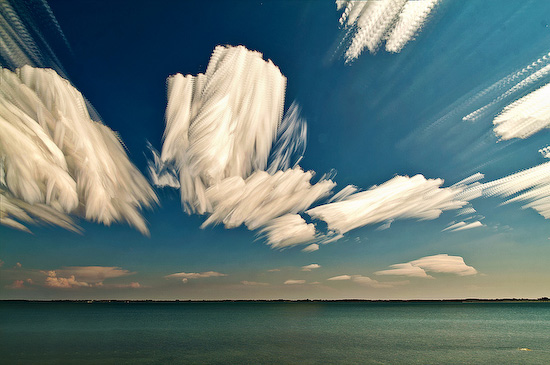Featured Products
Using timelapse videos as a source, Matt Molloy creates beautiful images that he calls “timestacks” in which only the sky is dynamic, traced by the clouds’ brush-like strokes.
The images have a high resemblance to paintings, because they’re composed from hundreds of photos. Having graduated from Graphic Design School, Matt discovered the interesting effect after years of experimentation.

Matt Molloy’s timestacks turn cloud movements into apparent brush strokes. Credits: Matt Molloy.
Inspired by “star trail” photos
Living on the shore of Lake Ontario, Canada, facing West, Matt naturally started capturing lots of sunset shots. During the same time he stumbled on “star trail” photos – composed from multiple exposures (or from timelapses) of the night sky, taken from a fixed position. He had the inspired idea of combining the two, which resulted in the spectacular images of brush-stroke skies.
He calls the technique “timestack”, a term which will likely hold up, considering the photos’ success. Matt’s very first timelapse to timestack sunset went viral after The Milky Way Scientists community posted it on their Facebook page, where it accumulated 12,000 likes and 4,000 shares in a single day.
Matt uses an intervalometer to control the camera
Matt’s usual set-up consists of a Canon 60D, attaching a battery grip for extended sessions, a Tamron 10-24mm wide-angle zoom lens, a tripod, and an assortment of filters, including a dark neutral-density and a circular polarizer.
As important is the automation of the photographic process, using an intervalometer software. The program, called Magic Lantern, automatically take pictures at fixed intervals, allowing Matt to sit back and enjoy or study the scene, as opposed to developing carpal tunnel syndrome by robotically pressing the shutter button himself.
The photographer insists that setting the interval between shots (1 to 6 seconds) has a high impact on results, and one should take into account the multitude of possible lighting and atmospheric conditions.
Postprocessing is programmed also
Assembling the images in Photoshop is also recommended to be achieved via automation. Matt uses a script from Star Circle Academy, after manually stacking the first couple of shots. The script completes the process through a Layer Blending mode. Each extra photo is stripped of its content, except for the lighter shades compared to the previous existing layers.
Matt says that depending on the aforementioned lighting and weather conditions, timestacks can vary from 30 to more than 400 compiled photos.
He’s a fan of the do-it-yourself aesthetic and encourages anyone to ask him for technical advice.
You can contact Matt Molloy and browse an extensive gallery of his timestacks at his Flickr page.






































